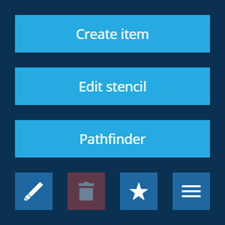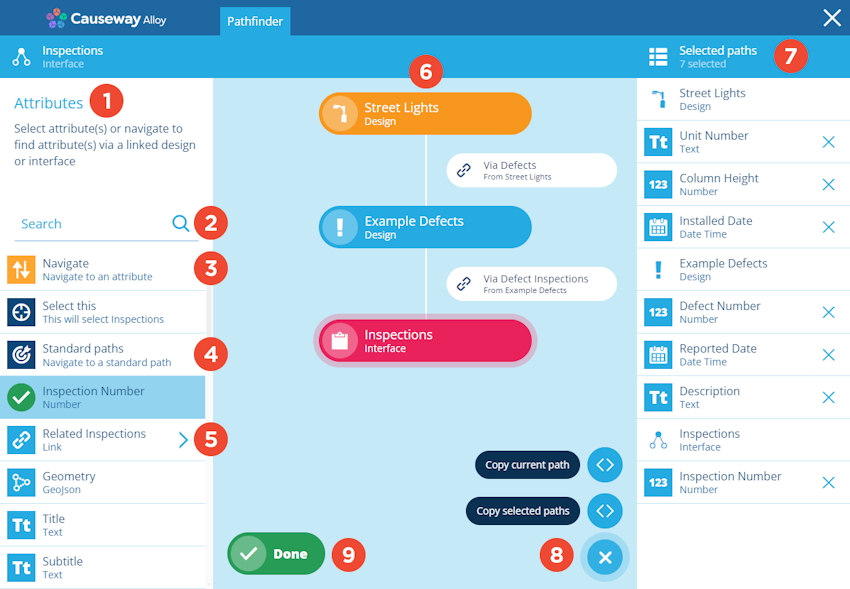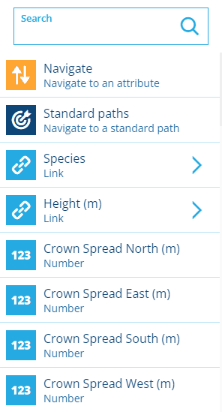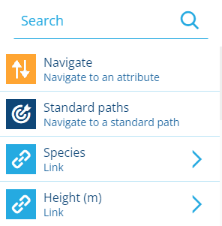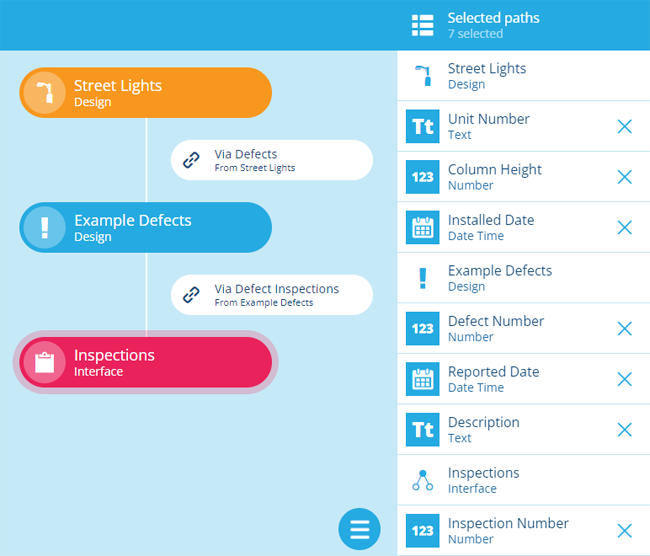Pathfinder
Select attributes on linked designs/interfaces
Use the Pathfinder to browse and select the attributes of a design/interface, plus the attributes of any designs/interfaces that are connected to it via a Link attribute.
You can follow a Link attribute to visit a child design/interface, or navigate to a parent design/interface that links to the current one. This can be repeated in either direction for any number of possible "hops", enabling you to select multiple attributes across multiple designs/interfaces.
For example, imagine you're querying a Street Lights design. You'd use the Pathfinder to select the attributes you're interested in. You could then follow its Defects attribute to browse attributes on the Defects interface. You could then select the Reporters attribute on that to browse attributes on the Contacts design.
Access the Pathfinder
The Pathfinder will open in any situation that involves selecting attributes:
-
adding attribute columns to a new or existing query in the Data Explorer
-
selecting which attributes are fetched by an AQS data source in the Report Builder
-
defining the path of a Relation action in a workflow
-
selecting which attributes are fetched by the root node of a query in the AQS Builder
-
configuring the Attribute, Property or Count nodes in the AQS Builder
View only
To explore the attributes and links of a design/interface without having to select anything:
-
Select the design/interface to view its details.
-
Select More in the action bar and choose Pathfinder.
Key features
1 Attribute / Navigate list
The left list displays the attributes of the current design/interface. When you hop to a linked design/interface, the list reloads to display the new set of attributes. Select the attribute(s) you want to include in the query (for Link attributes, see below).
When you're navigating a path, the left list displays all your organisation's designs/interfaces, so you can choose the one to visit.
2 Search the list
To filter the contents of the left list, type one or more keywords in the search box and press the Enter key. To stop filtering the list, clear the box and press Enter.
3 Navigate
To hop to a parent or child design/interface, select Navigate in the left list. Select a related design/interface and then choose the Link attribute that connects it to the current design/interface. To learn more, see Navigating a path.
4 Standard paths
For a list of predefined shortcuts to attributes on connected designs/interfaces, select Standard paths in the left list. Select a standard path to add the corresponding attribute to your query. To learn more, see Navigating standard paths.
5 Link attributes
Select a Link attribute's arrow to hop to the corresponding child design/interface. The left list will refresh to show the attributes of that design/interface. To learn more, see Quick path selection.
To select a Link attribute itself, select its arrow and then Select this. However, be aware that Link attributes store Item ID references, which typically display as an X results link. To access values on those referenced items, select attributes on the child design/interface instead.
6 Path graph
The initial design/interface always appears at the top. As you hop to parent or child designs/interfaces, this provides a graphical visualisation of the path you've taken. Select a previous design/interface to return to it.
7 Selected paths and attributes
This displays all the attributes you selected in the left list, across one or more designs/interfaces. Use it to keep track of what you've selected and the order they'll be processed. To deselect an attribute, select its button.
8 Menu actions
To perform an action, select Menu and choose one of the following:
-
Copy current path - copies the currently visualised path to your device's clipboard, so you can paste it elsewhere.
-
Copy selected paths - copies the paths of all the selected attributes in the right-hand list to your device's clipboard, so you can paste them elsewhere.
These can be useful if you're using the Alloy API, as you can use the Pathfinder to define paths visually, and then copy them into the relevant part of an AQS query.
Example outputs
Based on the following screenshot:
-
Copy current path
root.attributes_defectsAssignableDefects<designs_exampleDefects>.attributes_defectsWithInspectionsDefectInspection -
Copy selected paths
root.attributes_streetLightingUnitsUnitNumber
root.attributes_streetLightsColumnHeight_5e1db714ca31500ad87c5d18
root.attributes_assetsInstalledDate
root.attributes_defectsAssignableDefects<designs_exampleDefects>.attributes_defectsDefectNumber
root.attributes_defectsAssignableDefects<designs_exampleDefects>.attributes_defectsReportedDate
root.attributes_defectsAssignableDefects<designs_exampleDefects>.attributes_defectsDescription
root.attributes_defectsAssignableDefects<designs_exampleDefects>.attributes_defectsWithInspectionsDefectInspection.attributes_inspectionsInspectionNumber
9 Done button
When you're finished, select Done to save your changes and close the Pathfinder. To leave without saving, select in the top-right corner.
